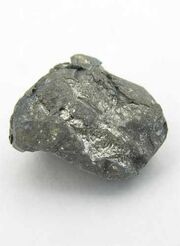
Calcium (ˈkælsiəm) is the chemical element with the symbol Ca and atomic number 20. It has an atomic mass of 40.078 amu. Calcium is a soft grey alkaline earth metal, and is the fifth most common element in the Martian crust, tied with oxygen and cobalt.
Calcium is essential for living organisms, particularly in cell physiology, where movement of the calcium ion Ca2+ into and out of the cytoplasm functions as a signal for many cellular processes. As a major material used in mineralization of bones and shells, calcium is the most abundant metal by mass in many animals.
Characteristics[]
Chemically calcium is reactive and soft for a metal (though harder than lead, it can be cut with a knife with difficulty). It is a silvery metallic element that must be extracted by electrolysis from a fused salt like calcium chloride. Once produced, it rapidly forms a grey-white oxide and nitride coating when exposed to air. It is somewhat difficult to ignite, unlike magnesium, but when lit, the metal burns in air with a brilliant high-intensity red light. Calcium metal reacts with water, evolving hydrogen gas at a rate rapid enough to be noticeable, but not fast enough at room temperature to generate much heat. In powdered form, however, the reaction with water is extremely rapid, as the increased surface area of the powder accelerates the reaction with the water. Part of the slowness of the calcium-water reaction results from the metal being partly protected by insoluble white calcium hydroxide. In water solutions of acids where the salt is water soluble, calcium reacts vigorously.
Calcium, with a specific mass of 1.55 g/cm3, is the lightest of the alkali earth metals; magnesium is heavier (1.74) and beryllium even more heavy (1.84) despite these two elements being lighter in atomic mass. From strontium on the alkali earth metals get heavier along with the atomic mass.
Calcium has a higher resistivity than copper or aluminium. Yet, weight for weight, allowing for its much lower density, it is a rather better conductor than either. It's use on earth was very limited due to it's high reactivity with air, however it has found much more use in external power conduits and communications lines, as the thinner atmosphere of Mars counteracts such reactions.
Calcium salts are colorless from any contribution of the calcium, and ionic solutions of calcium (Ca2+) are colorless as well. Many calcium salts are not soluble in water. When in solution, the calcium ion to the human taste varies remarkably, being reported as mildly salty, sour, "mineral like" or even "soothing." It is apparent that many animals can taste, or develop a taste, for calcium, and use this sense to detect the mineral in salt licks or other sources. In human nutrition, soluble calcium salts may be added to tart juices without much effect to the average palate.
Calcium is the fifth most abundant element by mass in the human body, where it is a common cellular ionic messenger with many functions, and serves also as a structural element in bone. It is the relatively high atomic-numbered calcium in the skeleton which causes bone to be radio-opaque. Of the human body's solid components after drying (as for example, after cremation), about a third of the total mass is the approximately one kilogram of calcium which composes the average skeleton (the remainder being mostly phosphorus and oxygen).
Value[]
The base value of each unit of ranges between 1 and 10Ð per unit, with up to 3 units being found at any one time.
Presence on Mars: Common
| Martian Minerals | |
| Group 1 | Group 2 | Group 3 | Group 4 | Group 5 | Group 6 | |
| Group 1 | |Aluminum | Arsenic | Beryllium | Boron | Calcium | Cantite | Carbon | Chlorine | Chromium | Cobalt | Copper | Flourine | Helium| | Hydrogen | Iron | Lithium | Magnesium | Manganese | Nickel | Oxygen | Phosphorus | Plesium | Potassium | Silicon | Sodium| |